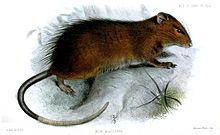Maclear's rat
| Maclear's rat | |
|---|---|

| |
| Scientific classification | |
| Domain: | Eukaryota |
| Kingdom: | Animalia |
| Phylum: | Chordata |
| Class: | Mammalia |
| Order: | Rodentia |
| Family: | Muridae |
| Genus: | Rattus |
| Species: | †R. macleari
|
| Binomial name | |
| †Rattus macleari (Thomas, 1887)
| |
| Synonyms | |
|
Mus macleari Thomas, 1887[2] | |
Maclear's rat (Rattus macleari) is an extinct large rat endemic to Christmas Island in the Indian Ocean. It was one of two species of rat native to Christmas Island, alongside the bulldog rat. Abundant, unfamiliar with and seemingly unafraid of humans, large numbers of the creatures emerged and foraged in all directions at night. Making querulous squeaks, the rats entered the Challenger expedition's tents and shelters in 1886, ran over sleepers, and upset everything in the search and fight for food. Maclear's rat might have been responsible for keeping the population of the Christmas Island red crab in check, as recent numbers of the crab are greater than in the past. It is thought that black rats inadvertently introduced by the expedition infected the Maclear's rats with a disease (possibly a trypanosome),[3] which in turn could have contributed to the species' decline.[4] The last recorded sighting was in 1903, although it is possible that Maclear's rats hybridized with black rats.[5] A hard tick (Ixodes nitens), described as an ectoparasite of Maclear's rat, is also thought to be extinct.[6]

Said to be related to Rattus xanthurus of Sulawesi and R. everetti of the Philippines, this species was grizzled brown above and lighter on the underside. The lower back had prominent long and black hairs that projected above the shorter fur. The base of the tail was dark with the distal half being scaly white.[7]

The rat is named after Captain John Maclear (1838–1907) of the British survey-ship HMS Flying-Fish, who collected the specimen from Christmas Island in 1886. It was described as a new species by Oldfield Thomas the next year, although it was originally described under the genus Mus.[2][7] Maclear was earlier commander on HMS Challenger for the Challenger Expedition of 1872–1876 under its commission captain, Sir George Nares.
A DNA study found Maclear's rat to be the sister species of Hainald's rat native to the island of Flores, with the clade containing the two being sister to the clade containing Nesokia and Bandicota; this clade, in turn, is sister to the Australasian Rattus radiation, making Rattus as currently defined paraphyletic.[8]
See also[edit]
References[edit]
- ^ Lamoreux, J.; Woinarski, J.; Burbidge, A.A. (2016). "Rattus macleari". IUCN Red List of Threatened Species. 2016: e.T19344A22440729. doi:10.2305/IUCN.UK.2016-1.RLTS.T19344A22440729.en. Retrieved 12 November 2021.
- ^ a b Thomas, Oldfield (1887). "Report on a Zoological Collection made by the Officers of HMS Flying-Fish at Christmas Island, Indian Ocean. Communicated by Dr. A. Gunther, VPZS, Keeper of the Zoological Department, British Museum". Proceedings of the Zoological Society of London: 513–514.
- ^ Pickering J. & Norris C.A. (1996). "New evidence concerning the extinction of the endemic murid Rattus macleari from Christmas Island, Indian Ocean". Australian Mammalogy. 19: 19–25. doi:10.1071/AM96019.
- ^ Wyatt KB, Campos PF, Gilbert MT, Kolokotronis SO, Hynes WH, et al. (2008). "Historical mammal extinction on Christmas Island (Indian Ocean) correlates with introduced infectious disease". PLOS ONE. 3 (11): e3602. Bibcode:2008PLoSO...3.3602W. doi:10.1371/journal.pone.0003602. PMC 2572834. PMID 18985148.
- ^ Flannery, Tim & Schouten, Peter (2001). A Gap in Nature: Discovering the World's Extinct Animals. Atlantic Monthly Press, New York. ISBN 978-0-87113-797-5.
- ^ Andrei Daniel Mihalca; Călin Mircea Gherman & Vasile Cozma (2011). "Coendangered hard-ticks: threatened or threatening?". Parasites & Vectors. 4: 71. doi:10.1186/1756-3305-4-71. PMC 3114005. PMID 21554736.
- ^ a b Harper, Francis (1945). Extinct and vanishing mammals of the Old World. New York: American Committee for International Wild Life Protection. pp. 206–208.
- ^ THOMSON, VICKI; WIEWEL, ANDREW; CHINEN, ALDO; MARYANTO, IBNU; SINAGA, M. H.; HOW, RIC; APLIN, KEN; SUZUKI, HITOSHI (2018-08-15). "A perspective for resolving the systematics of Rattus, the vertebrates with the most influence on human welfare". Zootaxa. 4459 (3): 431–452. doi:10.11646/zootaxa.4459.3.2. ISSN 1175-5334. PMID 30314119. S2CID 52975664.

